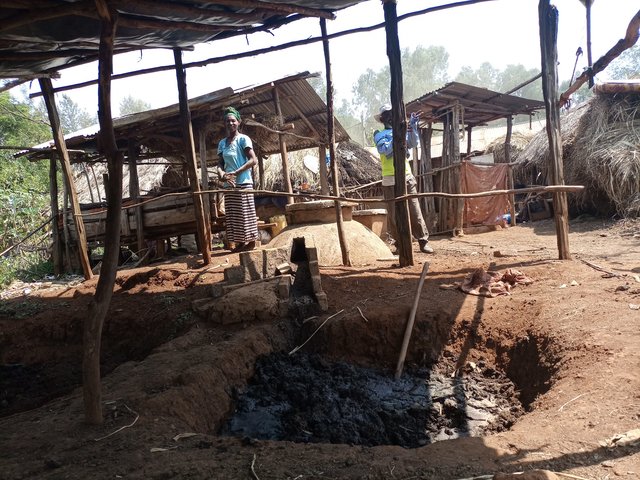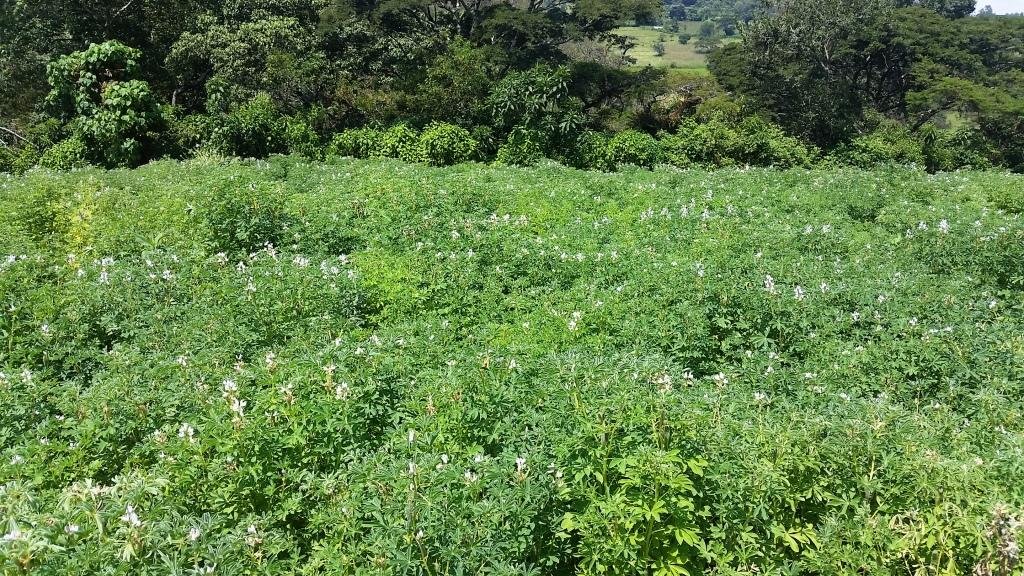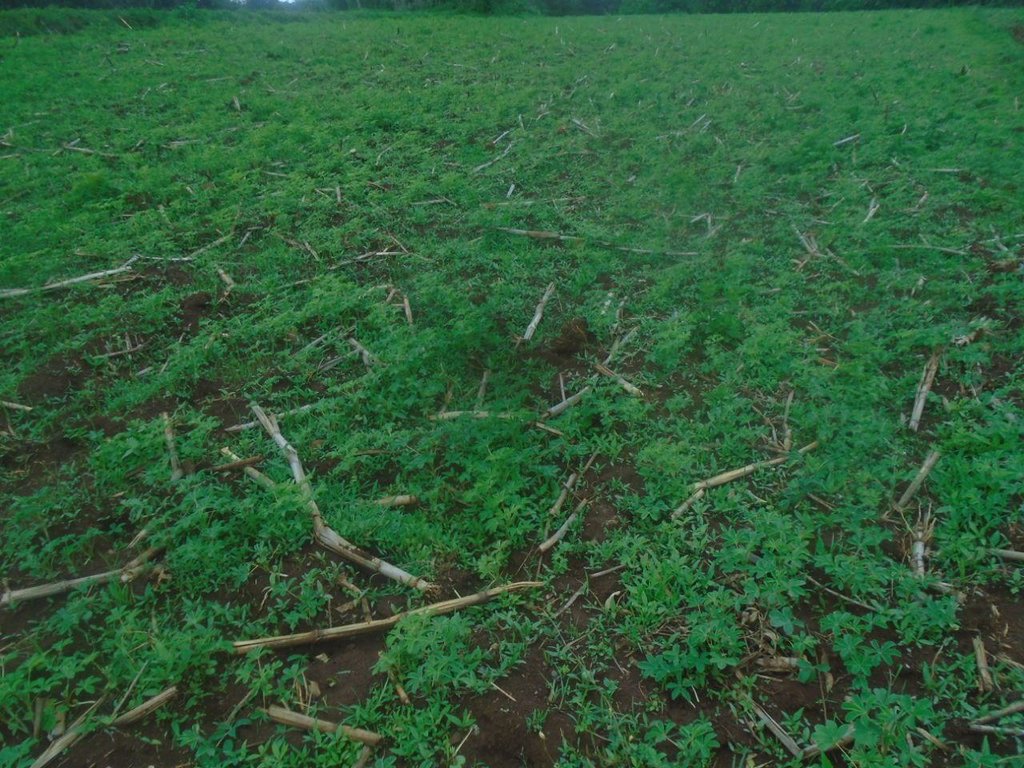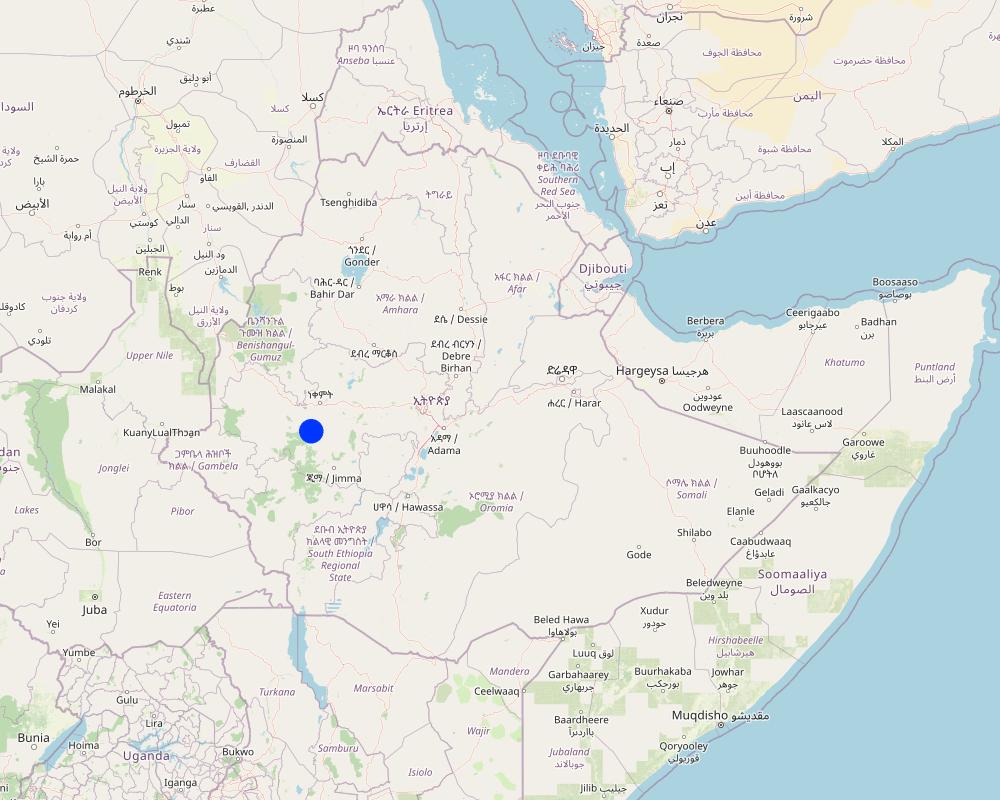Green Manures [Ethiopia]
- Creation:
- Update:
- Compiler: GERBA LETA
- Editors: Noel Templer, Julia Doldt, Kidist Yilma, Tabitha Nekesa, Ahmadou Gaye, Siagbé Golli
- Reviewers: William Critchley, Rima Mekdaschi Studer, Sally Bunning
Xa'oo Magarisaa
technologies_6645 - Ethiopia
View sections
Expand all Collapse all1. General information
1.2 Contact details of resource persons and institutions involved in the assessment and documentation of the Technology
Key resource person(s)
land user:
Gebremedhin Anbese
Farmer
Ethiopia
Name of project which facilitated the documentation/ evaluation of the Technology (if relevant)
Soil protection and rehabilitation for food security (ProSo(i)l)Name of the institution(s) which facilitated the documentation/ evaluation of the Technology (if relevant)
Alliance Bioversity and International Center for Tropical Agriculture (Alliance Bioversity-CIAT) - Kenya1.3 Conditions regarding the use of data documented through WOCAT
The compiler and key resource person(s) accept the conditions regarding the use of data documented through WOCAT:
Yes
1.4 Declaration on sustainability of the described Technology
Is the Technology described here problematic with regard to land degradation, so that it cannot be declared a sustainable land management technology?
No
1.5 Reference to Questionnaire(s) on SLM Approaches (documented using WOCAT)

Integrated Soil Fertility Management (ISFM) [Ethiopia]
The Integrated Soil Fertility Management (ISFM) approach has been adopted under the Integrated Soil Fertility Management Project (ISFM+). It was introduced as a quick-win solution to increase both crop and biomass production through the incremental promotion of varied but complementary technology packages.
- Compiler: GERBA LETA
2. Description of the SLM Technology
2.1 Short description of the Technology
Definition of the Technology:
Green manures are fast-growing legumes sown in a field, weeks or even months before the main crop is planted. These are plants that are deliberately grown for incorporation into the soil to improve fertility and organic matter content.
2.2 Detailed description of the Technology
Description:
Green manures are grown with the prime purpose of building up as much biomass as possible. However, they also play a role in covering the ground and protecting it from solar radiation and soil erosion. These are plants that are deliberately grown for incorporation into the soil to improve soil fertility and organic matter content. They are generally fast-growing legumes sown in a field several weeks or months before the main crop is planted. Legumes are chosen due to their ability to fix atmospheric nitrogen, their drought tolerance, quick growth, and adaptation to adverse conditions. Green manures have the potential to restore soil fertility and have an ameliorating effect on climate change via the sequestration of atmospheric carbon.
Green manures supply the soil with great amounts of fresh biomass. After incorporation into the soil, the biomass is decomposed by soil organisms within a few weeks under humid and warm conditions. Most nutrients are then readily available to a new crop. A small proportion is also transformed into stable soil organic matter, contributing to better soil structure, better aeration, improved drainage, increased soil water and nutrient holding capacity, and reduced erodibility of the soil by wind or water. Soil microbial activity is increased, as is the availability of macro and micronutrients in forms that the plants can use. They also have a root system that holds the soil in place.
Green manures are often applied to degraded land that demands management interventions. The purpose of introducing the technology reported here is primarily to multiply seeds for the scaling out of the technology. Among the common green manure crops which are being used in Ethiopia are lupin and lablab. Land users benefit from the sale of the seed itself as well as the fact that green manures increase production and help to changes unproductive and abandoned land into productive assets. This technology has been distributed to virtually all Integrated Soil Fertility Management project (ISFM+) intervention woredas/regions as a component of intervention technologies/practices.
2.3 Photos of the Technology
2.4 Videos of the Technology
Comments, short description:
Videos of this technology is not documented.
2.5 Country/ region/ locations where the Technology has been applied and which are covered by this assessment
Country:
Ethiopia
Region/ State/ Province:
Oromia
Further specification of location:
Mirga Mute, Bedele district
Specify the spread of the Technology:
- evenly spread over an area
If precise area is not known, indicate approximate area covered:
- < 0.1 km2 (10 ha)
Is/are the technology site(s) located in a permanently protected area?
No
Map
×2.6 Date of implementation
Indicate year of implementation:
2020
2.7 Introduction of the Technology
Specify how the Technology was introduced:
- through projects/ external interventions
Comments (type of project, etc.):
The technology was introduced by the Integrated Soil Fertility Management Project (ISFM+) of the GIZ.
3. Classification of the SLM Technology
3.1 Main purpose(s) of the Technology
- improve production
- reduce, prevent, restore land degradation
- conserve ecosystem
- preserve/ improve biodiversity
- create beneficial economic impact
3.2 Current land use type(s) where the Technology is applied
Land use mixed within the same land unit:
No

Cropland
- Annual cropping
- Lupine, Dolichos lablab...
Number of growing seasons per year:
- 1
Specify:
It is grown earlier in the main crop planting season before it plow over for the intended purposes.
Is intercropping practiced?
No
Is crop rotation practiced?
No
3.3 Has land use changed due to the implementation of the Technology?
Has land use changed due to the implementation of the Technology?
- No (Continue with question 3.4)
3.4 Water supply
Water supply for the land on which the Technology is applied:
- rainfed
3.5 SLM group to which the Technology belongs
- integrated crop-livestock management
- improved ground/ vegetation cover
- integrated soil fertility management
3.6 SLM measures comprising the Technology

agronomic measures
- A1: Vegetation/ soil cover
- A2: Organic matter/ soil fertility
- A3: Soil surface treatment

management measures
- M5: Control/ change of species composition
3.7 Main types of land degradation addressed by the Technology

soil erosion by water
- Wt: loss of topsoil/ surface erosion

chemical soil deterioration
- Cn: fertility decline and reduced organic matter content (not caused by erosion)
- Ca: acidification

physical soil deterioration
- Pc: compaction

biological degradation
- Bc: reduction of vegetation cover
- Bl: loss of soil life
3.8 Prevention, reduction, or restoration of land degradation
Specify the goal of the Technology with regard to land degradation:
- reduce land degradation
- restore/ rehabilitate severely degraded land
Comments:
It brings back degraded soil and revives its productive potential.
4. Technical specifications, implementation activities, inputs, and costs
4.1 Technical drawing of the Technology
Technical specifications (related to technical drawing):
No sketching is affixed as it is freely broadcasted in Ethiopian cases.
4.2 General information regarding the calculation of inputs and costs
Specify how costs and inputs were calculated:
- per Technology area
Indicate size and area unit:
1.5 Sanga
If using a local area unit, indicate conversion factor to one hectare (e.g. 1 ha = 2.47 acres): 1 ha =:
1ha = 8 sanga
other/ national currency (specify):
ETB
If relevant, indicate exchange rate from USD to local currency (e.g. 1 USD = 79.9 Brazilian Real): 1 USD =:
53.12
Indicate average wage cost of hired labour per day:
200
4.3 Establishment activities
| Activity | Timing (season) | |
|---|---|---|
| 1. | Land preparation | Dry season |
| 2. | Planting | Sow the green manure seeds during the short rainy season in March/April, about 45-60 days before planting the main crop. |
| 3. | Slash and plowing over | Plow in the green manure about 2 weeks before planting the main crop, i.e. in June/July. |
Comments:
GM are ideally allowed to grow up to the flowering stage when biomass is the greatest and the plant material will still easily decompose, as it is still green and not yet woody.
4.4 Costs and inputs needed for establishment
| Specify input | Unit | Quantity | Costs per Unit | Total costs per input | % of costs borne by land users | |
|---|---|---|---|---|---|---|
| Labour | Land preparation | PDs | 3.0 | 200.0 | 600.0 | 100.0 |
| Labour | Slashing and plow over | PDs | 1.5 | 200.0 | 300.0 | 100.0 |
| Labour | Planting | PDs | 1.5 | 200.0 | 300.0 | 100.0 |
| Plant material | Green manure seed | kg | 37.5 | 8.0 | 300.0 | |
| Total costs for establishment of the Technology | 1500.0 | |||||
| Total costs for establishment of the Technology in USD | 28.24 | |||||
If land user bore less than 100% of costs, indicate who covered the remaining costs:
The initial cost for introducing green manure seed is produced by ISFM+ of the GIZ.
Comments:
Labor and other input costs are frequently changing in current Ethiopia.
4.5 Maintenance/ recurrent activities
| Activity | Timing/ frequency | |
|---|---|---|
| 1. | Labor for land preparation, planting, and slashing over. | Before planting the main crop. |
Comments:
It is more important if green manure is frequently used to improve soil fertility. According to the land user, using green manure increased the harvesting of Faba beans by 50% from the indicated land unit.
4.6 Costs and inputs needed for maintenance/ recurrent activities (per year)
| Specify input | Unit | Quantity | Costs per Unit | Total costs per input | % of costs borne by land users | |
|---|---|---|---|---|---|---|
| Labour | Land preparation, planting, slashing and plow over | PDs | 4.5 | 200.0 | 900.0 | 100.0 |
| Plant material | Seeds | PDs | 37.5 | 8.0 | 300.0 | 100.0 |
| Total costs for maintenance of the Technology | 1200.0 | |||||
| Total costs for maintenance of the Technology in USD | 22.59 | |||||
Comments:
Once accessed, the land user is expected to retain seed for the other years to come. The cost estimated using a hectare of land is just to standardize using the SI unit and simplify understanding by the readers.
4.7 Most important factors affecting the costs
Describe the most determinate factors affecting the costs:
Cost is highly volatile in Ethiopia. It could be attributed to global and national economic crises and price changes.
5. Natural and human environment
5.1 Climate
Annual rainfall
- < 250 mm
- 251-500 mm
- 501-750 mm
- 751-1,000 mm
- 1,001-1,500 mm
- 1,501-2,000 mm
- 2,001-3,000 mm
- 3,001-4,000 mm
- > 4,000 mm
Specifications/ comments on rainfall:
Receives rainfall with a summer maximum. January to March is a dry season. The area receives short rains from March to April and maximum rain from June to September.
Indicate the name of the reference meteorological station considered:
Bedele
Agro-climatic zone
- sub-humid
5.2 Topography
Slopes on average:
- flat (0-2%)
- gentle (3-5%)
- moderate (6-10%)
- rolling (11-15%)
- hilly (16-30%)
- steep (31-60%)
- very steep (>60%)
Landforms:
- plateau/plains
- ridges
- mountain slopes
- hill slopes
- footslopes
- valley floors
Altitudinal zone:
- 0-100 m a.s.l.
- 101-500 m a.s.l.
- 501-1,000 m a.s.l.
- 1,001-1,500 m a.s.l.
- 1,501-2,000 m a.s.l.
- 2,001-2,500 m a.s.l.
- 2,501-3,000 m a.s.l.
- 3,001-4,000 m a.s.l.
- > 4,000 m a.s.l.
Comments and further specifications on topography:
The topography has a rolling feature that consistently changes.
5.3 Soils
Soil depth on average:
- very shallow (0-20 cm)
- shallow (21-50 cm)
- moderately deep (51-80 cm)
- deep (81-120 cm)
- very deep (> 120 cm)
Soil texture (topsoil):
- medium (loamy, silty)
Soil texture (> 20 cm below surface):
- medium (loamy, silty)
Topsoil organic matter:
- low (<1%)
5.4 Water availability and quality
Ground water table:
5-50 m
Availability of surface water:
good
Water quality (untreated):
good drinking water
Water quality refers to:
surface water
Is water salinity a problem?
No
Is flooding of the area occurring?
No
5.5 Biodiversity
Species diversity:
- medium
Habitat diversity:
- medium
Comments and further specifications on biodiversity:
There is high habitat biodiversity in the nearby remnant forest.
5.6 Characteristics of land users applying the Technology
Sedentary or nomadic:
- Sedentary
Market orientation of production system:
- mixed (subsistence/ commercial)
Off-farm income:
- 10-50% of all income
Relative level of wealth:
- average
Individuals or groups:
- individual/ household
Level of mechanization:
- manual work
- animal traction
Gender:
- men
Age of land users:
- middle-aged
Indicate other relevant characteristics of the land users:
The land user generates additional off-farm income is serving as a security guard for water depots that build for the nearby Bedele city.
5.7 Average area of land used by land users applying the Technology
- < 0.5 ha
- 0.5-1 ha
- 1-2 ha
- 2-5 ha
- 5-15 ha
- 15-50 ha
- 50-100 ha
- 100-500 ha
- 500-1,000 ha
- 1,000-10,000 ha
- > 10,000 ha
Is this considered small-, medium- or large-scale (referring to local context)?
- small-scale
5.8 Land ownership, land use rights, and water use rights
Land ownership:
- state
- individual, titled
Land use rights:
- individual
Water use rights:
- open access (unorganized)
- leased
Are land use rights based on a traditional legal system?
Yes
Specify:
The land user inherited the land from his father.
5.9 Access to services and infrastructure
health:
- poor
- moderate
- good
education:
- poor
- moderate
- good
technical assistance:
- poor
- moderate
- good
employment (e.g. off-farm):
- poor
- moderate
- good
markets:
- poor
- moderate
- good
energy:
- poor
- moderate
- good
roads and transport:
- poor
- moderate
- good
drinking water and sanitation:
- poor
- moderate
- good
financial services:
- poor
- moderate
- good
- poor
- moderate
- good
Comments:
Apart from electricity, the land user is closer to other public facilities and services.
6. Impacts and concluding statements
6.1 On-site impacts the Technology has shown
Socio-economic impacts
Production
crop production
crop quality
product diversity
land management
Comments/ specify:
It improves the organic matter content of the soil.
Water availability and quality
drinking water availability
drinking water quality
Income and costs
expenses on agricultural inputs
farm income
Socio-cultural impacts
food security/ self-sufficiency
health situation
SLM/ land degradation knowledge
Comments/ specify:
As it is evidence based practice, it improves land users knowledge about SLM.
Ecological impacts
Water cycle/ runoff
water quantity
water quality
surface runoff
excess water drainage
groundwater table/ aquifer
Comments/ specify:
There is no facts to validate regarding the status of groundwater table.
Soil
soil moisture
soil cover
soil loss
soil accumulation
soil crusting/ sealing
soil compaction
nutrient cycling/ recharge
Comments/ specify:
It improves soil nutrient cycling through adding more nutrients including by fixing atmospheric nitrogen.
soil organic matter/ below ground C
acidity
Biodiversity: vegetation, animals
Vegetation cover
biomass/ above ground C
plant diversity
beneficial species
habitat diversity
pest/ disease control
Climate and disaster risk reduction
emission of carbon and greenhouse gases
Comments/ specify:
Part of the plow over, remains undecomposed in the soil system and contributes to carbon sequestration.
6.2 Off-site impacts the Technology has shown
water availability
Comments/ specify:
Off-site water availability is expected to increase but the assumption needs long-term data and documentation.
reliable and stable stream flows in dry season
downstream siltation
impact of greenhouse gases
Specify assessment of off-site impacts (measurements):
As it is a recent introduction, the impact of the technology on the off-site is just conceptually judged.
6.3 Exposure and sensitivity of the Technology to gradual climate change and climate-related extremes/ disasters (as perceived by land users)
Gradual climate change
Gradual climate change
| Season | increase or decrease | How does the Technology cope with it? | |
|---|---|---|---|
| annual temperature | increase | moderately | |
| annual rainfall | decrease | not well |
6.4 Cost-benefit analysis
How do the benefits compare with the establishment costs (from land users’ perspective)?
Short-term returns:
positive
Long-term returns:
very positive
How do the benefits compare with the maintenance/ recurrent costs (from land users' perspective)?
Short-term returns:
positive
Long-term returns:
very positive
Comments:
The technology needs land users knowledge and skills and less of financial expenses.
6.5 Adoption of the Technology
- 1-10%
Of all those who have adopted the Technology, how many did so spontaneously, i.e. without receiving any material incentives/ payments?
- 0-10%
Comments:
Most adopters are member of the Farmers Research and Extension Group.
6.6 Adaptation
Has the Technology been modified recently to adapt to changing conditions?
No
6.7 Strengths/ advantages/ opportunities of the Technology
| Strengths/ advantages/ opportunities in the land user’s view |
|---|
| Improve soil fertility. |
| Reduce soil acidity. |
| Increase grain yield. |
| Strengths/ advantages/ opportunities in the compiler’s or other key resource person’s view |
|---|
| It stops the soil from being carried away by wind and rain by providing ground cover during early season when flash rain/wind causes erosion. |
| Increases soil microbial activity, and the availability of macro and micronutrients in forms that the plants can use. |
| After the plow over, most nutrients are then readily available to a new crop. |
6.8 Weaknesses/ disadvantages/ risks of the Technology and ways of overcoming them
| Weaknesses/ disadvantages/ risks in the land user’s view | How can they be overcome? |
|---|---|
| Labor demanding for establishment and maintenance. | Continues awareness raising work regarding the indirect benefits generated from the technology in terms of amending the soil fertility and reducing issues of soil acidity. |
| Lack of tangible benefit as most farmers expect yield. | Convince the land users about the indirect benefit accrued from using green manure. |
| Weaknesses/ disadvantages/ risks in the compiler’s or other key resource person’s view | How can they be overcome? |
|---|---|
| Farmers may be unwilling to put in the labor or buy the seed needed. | Advocate the sustainable benefits triggered by using green manures so that the mindset of the land users would be changed. |
| Lack of awareness of green manuring as a soil fertility management option since it is a recent innovation in Ethiopia. | Create more awareness and institutionalize its benefit in the mainstream agricultural extension system to reach out to large number of beneficiaries. |
| Many farmers look for an immediate economic product, such as grains, from any crop that is grown. | Again, this need familiarizing the land users to the in kind benefits accrued from the application of green manure. Demonstrating the technology and arranging experience exchange visit is pivotal to scale out the technology/practice. |
7. References and links
7.1 Methods/ sources of information
- field visits, field surveys
4
- interviews with land users
1
- interviews with SLM specialists/ experts
3
When were the data compiled (in the field)?
07/02/2023
7.2 References to available publications
Title, author, year, ISBN:
Managing Land: A practical guidebook for development agents in Ethiopia. 26. RELMA & MARD. 2005.
Available from where? Costs?
It is public resource.
7.3 Links to relevant online information
Title/ description:
Green Manures
URL:
https://www.daera-ni.gov.uk/articles/green-manures#
7.4 General comments
Some questions in the questionnaire are irrelevant to this particular technology.
Links and modules
Expand all Collapse allLinks

Integrated Soil Fertility Management (ISFM) [Ethiopia]
The Integrated Soil Fertility Management (ISFM) approach has been adopted under the Integrated Soil Fertility Management Project (ISFM+). It was introduced as a quick-win solution to increase both crop and biomass production through the incremental promotion of varied but complementary technology packages.
- Compiler: GERBA LETA
Modules
No modules





